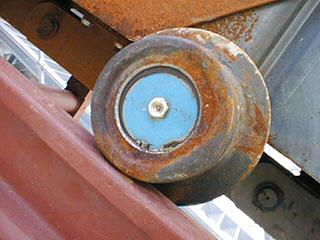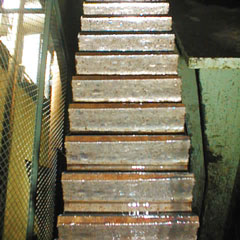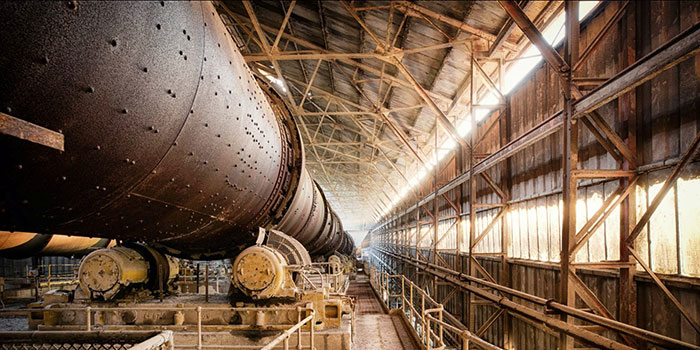Cement Industry Lubrication
The lubrication of plant in the cement industry offers some quite unique challenges. Admittedly there are numerous items of plant that are commonly found in many other industries, gearboxes and bearings for example, of which there are many and diverse types. However, it is not so much the type of equipment that is the issue in this industry but the environment in which these items of plant are operating on a daily basis, which can also vary from season to season depending on the global location of these plants. It is this parameter alone which maintenance personnel operating in the cement industry must consider very carefully when both selecting and applying lubricants, because lubricants that work well in almost identical equipment in other, perhaps not so arduous conditions, might not be so effective in this industry. Let us consider some key applications which will hopefully throw some light on these nuances.

Quite often a cement plant is located adjacent to, or very near, a quarry so some of the raw material has to be transported from this quarry right into the cement plant and eventually into very large storage hoppers, and the transportation is most commonly undertaken by conveyors of which the most common type are belt conveyors. Even if the raw material is brought into the plant by transport from a source some distance away there will still be numerous conveyors throughout a cement plant. Such conveyors are usually driven by electric motors, some of which will be large due to the power required to pull the belts a long distance. These larger types will have grease nipples that will require greasing infrequently. There will also be greased bearings on drive shaft bearings at both the Drive End as well as the NonDrive End and often on Tension Rolls in between. Many different types of greases are successfully used in these types of applications and the type of grease used is not as important as the frequency of greasing, purely to keep the dust out of the races, which would otherwise result in rapid wear rates. As these conveyors are often located outside and open to all weathers it is not uncommon to utilise a water resistant grease in order to attempt to prevent water ingress which, combined with the dust, would eventually lead to a very superior grinding paste.
As I have already indicated, the frequency of greasing is the most important pre-requisite and the problem often arises that greasing is not done frequently enough because of the distances between greased bearings and the height above ground level. Labour availability can also add to this problem. The use of centralised greasing systems whereby a centrally located reservoir feeding numerous points through pipework, can sometimes be considered but the pipe runs could potentially be very long, so a number of these would have to be considered. The other alternative, and one that is often used, is single point grease lubricators that screw directly into each bearing and which are available in different sizes. These lubricators can be set to expel their grease over variable amounts of time to suit the application and bearing size.
The distinct advantage of these types of lubricators is that the labour requirement to individually grease the bearings is significantly reduced, and that there is always a constant pressure on the bearing which will help to alleviate the ingress of contaminants. Their total cost throughout a plant, based on the number required would have to be weighed up against the comparative labour element, and it must not be overlooked that a proper planned maintenance system would have to incorporate their inspection on a pre-determined time schedule to make sure that they are working properly and that they have not expired. No automatic lubrication system should ever be incorporated on a “fit and forget” approach.
Conveyors are driven by reduction gearboxes of many different types but very often worm gearboxes, in order to allow the electric motor to sit adjacent to the conveyor and not to protrude too excessively. In these instances a very simple oil of the correct viscosity, which would normally be a mineral oil of I.S.O. Viscosity Grade 220 or 320 can be used, and does not necessarily have to possess extreme pressure properties. Gearboxes and bearings are also found in the numerous crushers that are located in the Infeed section of the quarry but suffer the same issues as for the conveyors in terms of dust. Here, centralised greasing systems are commonly used as the bearings are located very close to each other ensuring that the pipe runs are not too long, and the grease reservoir can quite easily be housed inside. The gearboxes are usually very large, and have a large oil capacity with the gear teeth often experiencing high shock loading, so extreme pressure gear oil is most commonly used for this reason alone. Crusher gearboxes benefit greatly from regular oil analysis and condition monitoring as the small sample required (approximately 100ml) does not affect the overall oil level and the information gained from the subsequent oil analysis can save a great deal of money in respect of unplanned downtime, and the associated costs of lost production.
 There are many open gears associated with a cement plant, perhaps in Ball Mills as well as Rotary Kilns, to highlight but two, and usually there are many different types of lubricants used as well as many different methods of application. The main requirement for open gears is that the lubricant should be able to adhere for the entire revolution of the driven gear in order to offer that protection mentioned, but the only lubricating requirement is when the driving pinion is mating. Therefore, the best lubricants for these applications are purpose made open gear lubricants which ideally are sprayed onto the teeth, just before the pinion and driven gear mate, but the spray pattern is critical in order for the coverage of the mating teeth to be sufficient. Often the lubricant is sprayed directly from a barrel due to the quantity required, particularly in respect of a Rotary Kiln, and the lubricant might need to have a certain degree of heat resistance, again in respect of a Rotary Kiln, as it must not be able to melt away for that revolution.
There are many open gears associated with a cement plant, perhaps in Ball Mills as well as Rotary Kilns, to highlight but two, and usually there are many different types of lubricants used as well as many different methods of application. The main requirement for open gears is that the lubricant should be able to adhere for the entire revolution of the driven gear in order to offer that protection mentioned, but the only lubricating requirement is when the driving pinion is mating. Therefore, the best lubricants for these applications are purpose made open gear lubricants which ideally are sprayed onto the teeth, just before the pinion and driven gear mate, but the spray pattern is critical in order for the coverage of the mating teeth to be sufficient. Often the lubricant is sprayed directly from a barrel due to the quantity required, particularly in respect of a Rotary Kiln, and the lubricant might need to have a certain degree of heat resistance, again in respect of a Rotary Kiln, as it must not be able to melt away for that revolution.
Both grease type lubricants as well as thick oils with tackifier additives can be used, so long as they can be sprayed, and they must have the correct load carrying ability and body to withstand the potentially high loads that will be experienced. Conventional greases are not suitable, even though I have seen these being used, as they do not possess the aforementioned requirements. It is also important to inspect the gear teeth on occasions so that there is not any uneven wear taking place, which could be the result of an ineffective lubricant coverage.
Rotary Kilns provide their own lubrication challenges for both bearings and gearboxes, due to their slow rotation, high loading, and the thermal transfer of the process heat. It is quite common for the gearbox oil to operate on a circulation system utilizing both heat transfer systems and filtration. It is not unusual for the oil to be synthetic, but this is not always necessary if the flow rate is adequate and the heat transfer system efficient. Indeed, the inherent frictional characteristics of specific types of synthetic lubricants might be highly advantageous, as might be the high viscosity index offering desirable viscosity-temperature characteristics. The grease selected might also be synthetic for obvious reasons, and the selection of synthetic grease is probably more important than the selection of synthetic oil for the gearbox, as the greased bearing will not provide the same cooling effects.
There exists in a cement plant slow moving conveyors that transport the material directly from the kilns, sometimes called Clinker Conveyors, and very often they are constructed totally of metal, due to the heat experienced, and are basically a series of buckets that are hinged together. They are often carried by wheels on guide rails which will have a grease nipple in the centre which, due to their adverse operating conditions, i.e. both dusty and hot, will require very frequent greasing. Centralized greasing systems would not work in this type of application due to the constant movement of the wheels, so a system has to be installed that travels with the buckets for a short distance with the greasing probes automatically projected into the grease nipple, often in pairs. This automatic system works very well but, again, due to the many moving parts and associated sensors has to be checked on a regular basis, and accommodated within a planned maintenance system.
 The lubrication of a cement plant is not difficult, but experience is required in both the types of lubricants utilized for the many diverse applications, and the method and frequency that they are applied. A common requirement for such a large business as this is for the rationalization of the lubricant stock to make lubricant application as simple a task as possible, and this can be achieved to some degree most certainly, but there are specific applications where specialized lubricants have a significant advantage and should seriously be considered. Their increased initial cost will result in larger savings in the long run due to longevity of plant life and reduced downtime, of the unplanned type. Consideration should also be given to the use of synthetic gear lubricants in larger geared drives as their potential savings on the power consumed can be significant.
The lubrication of a cement plant is not difficult, but experience is required in both the types of lubricants utilized for the many diverse applications, and the method and frequency that they are applied. A common requirement for such a large business as this is for the rationalization of the lubricant stock to make lubricant application as simple a task as possible, and this can be achieved to some degree most certainly, but there are specific applications where specialized lubricants have a significant advantage and should seriously be considered. Their increased initial cost will result in larger savings in the long run due to longevity of plant life and reduced downtime, of the unplanned type. Consideration should also be given to the use of synthetic gear lubricants in larger geared drives as their potential savings on the power consumed can be significant.

Every Cement Plant operates differently and will have its own existing lubrication strategies, preferences (maybe based on historical issues), historical problems which are not insurmountable, Planned Maintenance requirements, management structure and type of workforce available, but there will be an optimum solution in respect of the lubricants selected, the equipment utilized to apply those lubricants, and the eventual Planned Maintenance regime, which can quite efficiently be combined with appropriate condition monitoring techniques wisely utilized. It is always advisable to analyze a large industrial plant, such as a Cement Plant, as a single entity so that both lubrication, and condition monitoring, strategies are perfectly co-ordinated with maintenance regimes to ensure that existing, or newly revised, Planned Maintenance systems are perfectly matched. In this way management can more effectively operate their plants more efficiently and more cost effective.
It is not so much the type of equipment that is the issue in his industry but the environment in which these items of plant are operating
Gearboxes benefit greatly from regular oil analysis and condition monitoring and the information gained from the subsequent oil analysis can save a great deal of money in respect of un-planned downtime, and the associated costs of lost production.
The lubrication of a cement plant is not difficult, but experience is required in both the types of lubricants utilized for the many diverse applications, and the method and frequency that they are applied.
